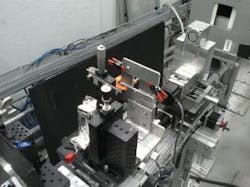MIT and NASA researchers develop microscope prototype that uses neutrons
Researchers at MIT and NASA have developed a new concept for a microscope that would use neutrons instead of beams of light or electrons to produce high-resolution images.
The concept would allow the microscope to probe inside metal objects such as fuel cells, batteries, and engines—even while they are in use—in order to learn details of their internal structure, according to MIT.
Without the proper optical components, existing neutron instruments produced weak images, according to Professor David Moncton, an author of a research paper recently published in Nature Communications which was co-authored by MIT postdoc Dazhi Liu, research scientist Boris Khaykovich, and four others.
"For neutrons, there have been no high-quality focusing devices," Moncton said in the MIT press release. "Essentially all of the neutron instruments developed over a half-century are effectively pinhole cameras."
He continued, "But with this new advance, we are turning the field of neutron imaging from the era of pinhole cameras to an era of genuine optics."
It is explained in the MIT release that light can be reflected in cases where its interaction with the surface is very small, as long as the light is coming in at a shallow angle. Mirrors with certain coatings are able to reflect neutrons at shallow angles, so the team created a prototype which is comprised of several reflective cylinders nested one inside the other, so as to increase the surface area available for reflection.
Though the device was initially designed and optimized digitally, a small proof-of-principal device was created and tested using a neutron beam at MIT’s Nuclear Reactor Laboratory. The resulting device could improve the performance of existing neutron imaging systems by a factor of about 50, according to the researchers, which would allow for much sharper images, smaller instruments, or both.
In addition, the microscope could be used to observe and characterize many kinds of materials and biological samples, as well as potentially open up new areas of research. The team—which is supported by the U.S. Department of Energy— is planning to build an optimized neutron-microscopy system in collaboration with NIST, which already has a major neutron-beam research facility.
Roger Pynn, a materials scientist at the University of California at Santa Barbara who was not involved in this research, told MIT, "I expect it to lead to a number of breakthroughs in neutron imaging. … It offers the potential for some really new applications of neutron scattering — something that we haven’t seen for quite a while."
View the press release.
View the research paper.
Also check out:
Laser imaging technique shows surgeons where tumors are in the brain
Automated vision system studies, analyzes plant growth for crop improvement purposes
EMCCD cameras used for ultra-cold atom research
Share your vision-related news by contacting James Carroll, Senior Web Editor, Vision Systems Design
To receive news like this in your inbox, click here.
Join our LinkedIn group | Like us on Facebook | Follow us on Twitter | Check us out on Google +
About the Author

James Carroll
Former VSD Editor James Carroll joined the team 2013. Carroll covered machine vision and imaging from numerous angles, including application stories, industry news, market updates, and new products. In addition to writing and editing articles, Carroll managed the Innovators Awards program and webcasts.
